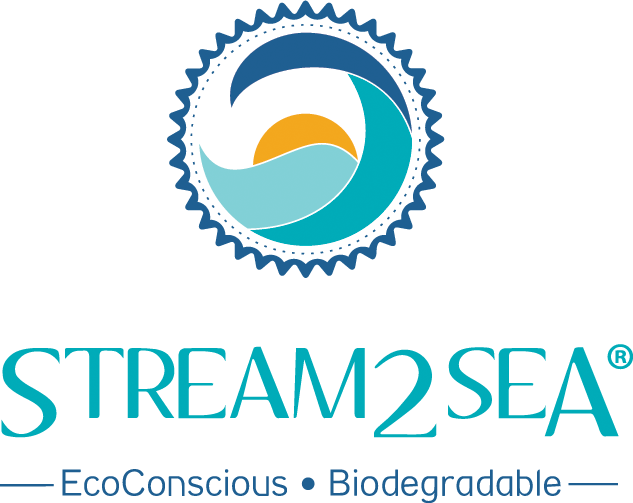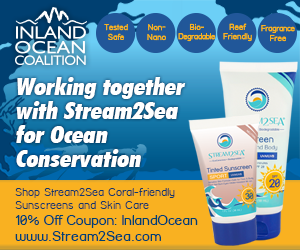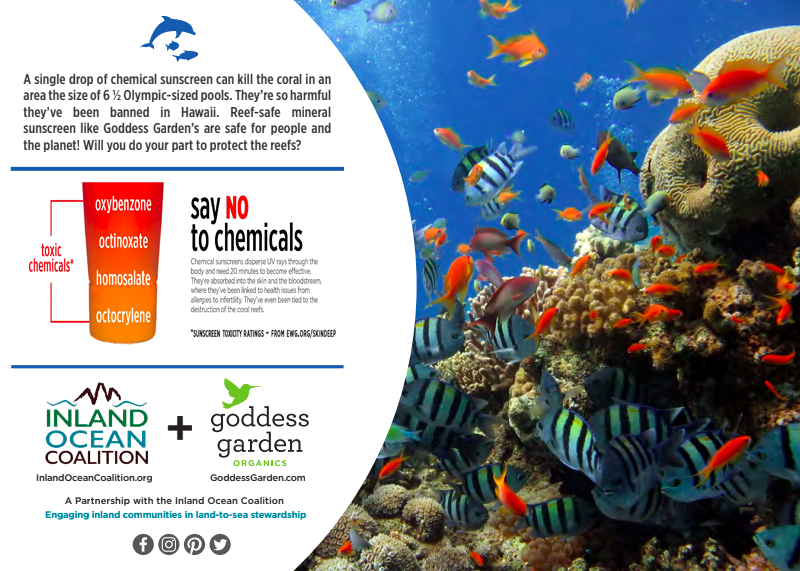The goal of our Petrochemical-Free Sunscreen Campaign is to decrease the use of harmful chemical sunscreens worldwide. We urge everyone to choose sunscreen free from synthetic chemicals that harm marine and aquatic ecosystems and encourage retailers to support this shift by making alternative sunscreens available.
This campaign was inspired by Hawaii’s historic ban on the chemicals oxybenzone and octinoxate, which have been proven to harm coral reefs. As the first place in the world to initiate this ban, Hawaii has helped us reach an important conservation milestone. Each year, 28,000,000 pounds of sunscreen wind up in waters that are home to coral reefs, but 1 drop of oxybenzone is toxic enough to contaminate 6.5 Olympic sized pools worth of water and seriously damage and even kill corals. In Hawaii, concentrations more than 10 times that amount have been measured at popular beaches. Since coral reefs support nearly 25% of all marine life, harming them endangers the ocean’s entire ecosystem. That’s why we’re pledging to choose reef safe sunscreens and ask you to join us.
That’s why we’re encouraging everyone to choose petrochemical-free sunscreens and ask that you join us.
ABOUT OUR COALITION
The Inland Ocean Coalition and Rotary Reefs together have a powerful network of change makers dedicated to saving coral reefs and marine biodiversity around the world. We see a unique opportunity to partner in the creation of a Petrochemical Sunscreen Ban Playbook that can be used globally to establish grassroots ban campaigns in coastal communities. We are also working with Sun Divers Roatán, Roatán Marine Park, Bay Island Conservation Association, and Haereticus Environmental Laboratory on this campaign.
THE PROBLEMS WITH PETROCHEMICAL SUNSCREENS
Although individuals living inland may not have direct contact with the ocean, their sunscreen might. Oxybenzone is an active ingredient found in many products—including sunscreen—that is absorbed into the skin when applied, and can be detected in urine 30 minutes after sunscreen is applied.
This means that when you go to the bathroom or take a shower, the chemicals in your sunscreen are washed down the drain and into wastewater treatment facilities. Oxybenzone, octinoxate, and many other sunscreen chemicals bypass our wastewater treatment facilities and end up back in the environment.
The chemicals travel downstream and may eventually reach the ocean, where they have toxic effects on coral, fish, algae, sea turtles, and even marine mammals, including endocrine disruption, DNA damage, and even death. Many sunscreen chemicals such as Oxybenzone, Octinoxae, Octocrylene, Octisalate, Avobenzone, and Homosalatecan also exacerbate coral bleaching by weakening the corals and increasing their susceptibility to bleaching.
Since applying sunscreen is a common practice for outdoor recreation, the chemicals found in most sunscreens are directly washed into our rivers, lakes, and ocean, where they also have negative impacts on these ecosystems and aquatic organisms.
HERE'S WHAT MIGHT BE IN YOUR SUNSCREEN
- Oxybenzone/benzophenone-3 (BZ): Found in many sunscreen products to block UV rays, over 50 studies have shown it to be harmful to reproduction and overall health of many animals, including mammals and corals.
- 4-methylbenzylidene camphor (MBC): Often added as a UV blocking chemical to sunscreen lotions and a myriad of other cosmetic products, even though it is not allowed by the US Food and Drug Administration (FDA) to be used as a sunscreen ingredient in sunscreen products for human topical use. Because of a loophole, it can be added to sunscreen lotion as a UV-stabilizer for fragrances, with some products containing up top 2.5% or more. MBC does contribute to the overall SPF rating, but it should technically not be allowed to add to this contribution.
- Octinoxate (also called octyl methoxycinnamate): Used as a legal UV-blocking ingredient, though a number of studies have shown it to be an endocrine disruptor, causes fish and oyster larval deformities, and can induce coral bleaching.
- Avobenzone: A less stable derivative of oxybenzone, avobenzone is a less effective UV absorber than oxybenzone. When added to a product containing octinoxate, it will rapidly break down in the presence of light. Avobenzone can cause coral bleaching, is a thyroid poison in fish, and is a mitochondrial poison.
- Polyethylene (specifically polyethylene microbeads): meant to add a “luxurious” and smooth feel to sunscreen (and many other personal care products), polyethylene microbeads are tiny pieces of plastic that ultimately end up on our waterways and the ocean. In 2018, microbeads in many cosmetic products were banned in the U.S., but in 2019, over 30,000 personal care products contained microplastics.
- Homosalate: Another popular and legal UV-sunscreen ingredient. In 2021, the European Commission’s Scientific Committee on Consumer Safety recommended that no personal care products contain homosalate of more than 0.5% (v/v) because it posed as a endocrine disruptor to reproductive, developmental systems in humans. It causes embryonic deformities in fish, as well as being genotoxic (poisonous to our DNA).
- Octisalate: A popular UV-sunscreen ingredient of which very little is known about its toxicity, particularly regarding long-term exposure, but which can also act as an endocrine disruptor.
- Octocrylene: Octocrylene is being pulled from many sunscreen products across the world because it breaks down in the product container to a carcinogenic chemical called benzophenone. Benzophenone is a Monsanto-patented herbicide. It can cause bleaching in coral and developmental deformities in fish, worms, crabs, and bivalves.
- Parabens: There are at least six different parabens that are used as product preservatives. Parabens induce a number of toxic effects in humans, corals, and other species. First, it is known to be an estrogenic endocrine disruptor. Second, it can cause oxidative damage to DNA, meaning that it causes mutations and can induce proliferation of some types of cancer cells, particularly breast cancers. Third, it is associated with a significant drop in male infertility by damaging the mitochondria of sperm.
- PABAs (para-aminobenzoic acids): PABAs come in a number of different chemical derivatives. They are another UV-sunscreen chemical, but because of consumer avoidance of this chemical, many manufacturers have removed it from their products. It causes allergic contact dermatitis, but the primary concern centers around a number of studies that show PABAs of being broad-range endocrine disruptors. Besides acting like an estrogen, it has also been shown to disrupt thyroid function and there is evidence that it may be genotoxic, causing damage to DNA.
Nano vs. Non-Nano
In the US, the FDA has not defined nano and non-nano products, though the European Union and Australia has defined nanoparticles as less than 100 nm. The Environmental Working Group suggests using non-nano products over nano. The controversy of nano versus non-nano lies in the ability for nanoparticles to be absorbed through the skin and enter the body and bloodstream, increasing the risk of nanoparticles disrupting cell walls and tissues. Non-nano based products are recommended since they lie on the skin's surface and do not pose any harm.
Non-nano zinc oxide and titanium dioxide are considered better active ingredients in sunscreen compared to oxybenzone and other chemicals used in 80% of commercial sunscreens. Zinc oxide, although a natural compound, is rare in nature–therefore companies produce it in a lab to make a ‘natural identical mineral.’ Other natural ingredients in sunscreen include plant oils and butters which all have varying SPFs.
Beware of products labeled biodegradable or environmentally friendly. Although they may break down faster than other products, the amount of time they spend in aquatic environments can still harm corals and other organisms. When choosing a sunscreen, ignore the labels on the front that can be misleading and look at the active ingredients listed on the back.
IMPACTS
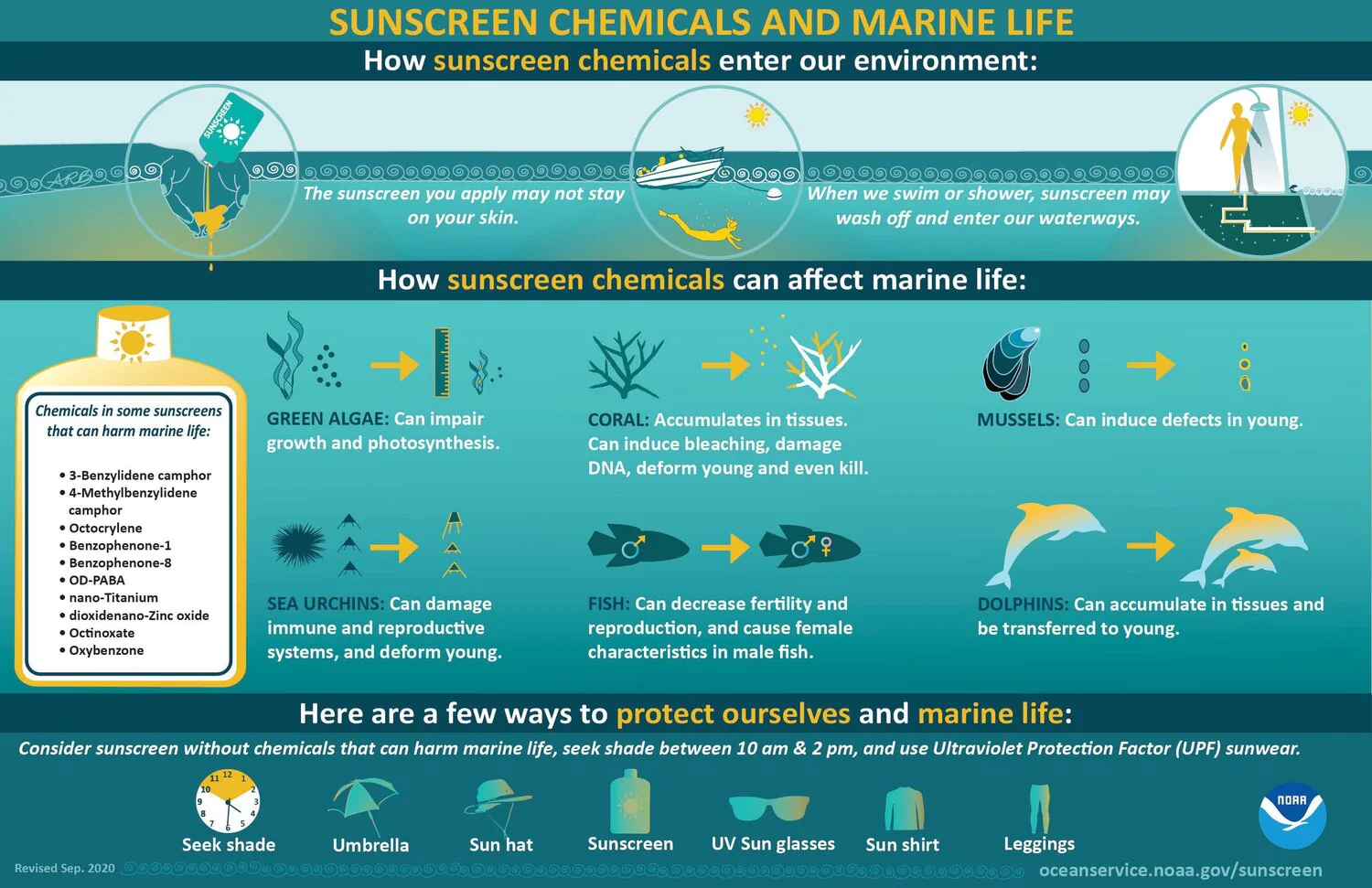
Humans
Many sunscreen ingredients, including Oxybenzone, Octinoxate, Homosalate, and Avobenzone, are readily absorbed through the skin and have shown to be endocrine disruptors that affect users' hormones and reproductive functions. Chemical sunscreen ingredients can also disrupt thyroid function and there is evidence that they may be carcinogenic as well as genotoxic.
Corals
Multiple active ingredients in sunscreen have been proven to contribute to the bleaching of coral, which can occur with stressors like an increase in temperature or pollution, which can cause corals to expel their symbiotic algae. Corals are animals that can't make their own food and have a unique relationship with plants called zooxanthellae. This symbiotic relationship allows corals to grow and flourish However, multiple active ingredients in petrochemical sunscreens have been proven to contribute to coral bleaching which often occur with stressors like an increase in temperature or pollution. These stresses can cause corals to expel their symbiotic algae. These algae, are the coral’s source of food and are what gives coral their vibrant color. Once the algae are expelled, the coral becomes white or “bleached.” This process reduces the ability of corals to survive and reproduce. It also damages coral DNA, which can lead to deformities. Ingredients like oxybenzone also act as an endocrine disruptor that cause coral larvae to encase themselves in their own stony skeleton during a crucial time in development. Oxybenzone and other petrochemicals are essentially herbicides that kill coral algae and can wreck havoc on an ecosystem. In addition, these chemicals when combined with increased sea temperatures will cause corlas to bleach sooner.
Coral reefs are already under great threat from pollution, overfishing, development, runoff, ocean acidification, disease, and more. Avoiding toxic sunscreen is one way you can help to protect the ocean and marine life for future generations.
Fish
Oxybenzone is toxic to fish and can result in the feminization in fish—both aquatic and marine. Male fish over time take on female attributes, making reproduction difficult and contributing to disease. Just remember—if it’s toxic to marine life and the environment, it’s probably not great for your health too!
Freshwater Organisms
Results of a 2020 study by the University of Alberta found that long-term exposure to chemicals like avobenzone, oxygenzone, and octocrylene are lethal to some freshwater organisms, including small fish and crustaceans, which form the basis of many freshwater ecosystems. One of the largest sources for these chemicals in both marine and freshwater ecosystems is the sunscreen leaching off people while swimming. And according to Dr. Linda Campell of St. Mary’s University, petrochemical sunscreens and sunscreens that use nano-particulate UV filters (think zinc and titanium) negatively impact freshwater algae and fish. Impacts can include DNA damage, bioaccumulation of toxic chemicals, and can harm organisms that make up the base of aquatic food webs.
Click here to listen to our podcast episode where we talk with Dr. Craig Downs, the Hawaiian scientist who discovered and popularized the threat petrochemical-based sunscreens and other skin care products pose to coral reefs, fish and additional marine wildlife.
Watch a short interview with Dr. Craig Downs here:
Other Options
Cover Up/Avoid the Sun at Peak Hours
Apart from applying sunscreen, there are other ways to protect from the sun’s harmful rays. Wearing hats, covering up with light weight clothing, wearing rash guards while in the water, staying in the shade, and choosing to be active in the morning or evenings will reduce your exposure to the sun's rays.
DIY Route
If you want to try and make your own homemade sunscreen, there are many resources on the web or at your local health food store. We do not recommend depending on homemade recipes before you fully test their potency and efficacy on your skin. Start your search here if you are interested in exploring natural sunscreen recipes.
Recyclability
When purchasing sunscreen also keep in mind if you’re able to recycle the product or even refill it. Buying sunscreen in bulk can save you money and reduce the amount of packaging used. Avoid buying sunscreen in aerosol containers, because more product will end up on the sand and in the environment rather than on your skin.
BEST PETROCHEMICAL-FREE SUNSCREEN CHOICES
Environmental Working Group's List of Top Recreational Sunscreens
Goddess Garden, Stream2Sea, All Good Products, Babo Botanicals, and Badger are all products that are better options for yourself and the environment. Besides containing either non-nano zinc oxide or titanium dioxide, these products also include aloe, healthy oils, and other natural ingredients.
CURRENT PETROCHEMICAL SUNSCREEN BANS
Hawaii, Key West in Florida, Palau, The U.S. Virgin Islands, Aruba, Bonaire, and Mexico have banned chemical sunscreens. Each ban came into effect at different times and in different manners. More countries and cities are likely to follow suit with their own bans.
